Janine Ashbless's Blog, page 142
November 21, 2011
Eyecandy Monday
Published on November 21, 2011 08:47
November 20, 2011
TftD: Strong

I've just written a (future) post snippet on balancing strong female and male characters, and I was reminded of this. Go Joss!
Published on November 20, 2011 10:18
November 18, 2011
Homework crisis

Heart of Flame is out on the 20th December, and Samhain prodded me till I squealed and agreed to do a blog tour for publicity purposes. In fact I'm doing two, in parallel. But not starting on 20th December - who the heck is on t'internet trawling for books over the holiday period? It all kicks off in the New Year.
This one is being organised by Goddess Fish, who - thank goodness - know what they're doing far better than I.
Of course I have to write all the posts (topics set by the hosts) well in advance and get them in ASAP. Which leaves me in the peculiar position of writing a post about my New Year Resolutions in November! It's like being back at school again and trying to get my homework in for all these subjects at once...
:-D

Published on November 18, 2011 09:21
November 16, 2011
Witch Wednesday ... part 2
 John William Waterhouse: Jason and Medea (1907)
John William Waterhouse: Jason and Medea (1907)
So here we are for a second week with Victorian and Edwardian witch paintings.
Having paid our respects to Circe, we're still with Greek mythology for the moment, but looking at an even scarier witch. Medea was actually Circe's niece, a priestess of the underworld/witchcraft goddess Hecate, and daughter of the king of Colchis (now Georgia). When Jason and the Argonauts arrived at her father's palace in search of the Golden Fleece, Medea fell in love and agreed to help him.
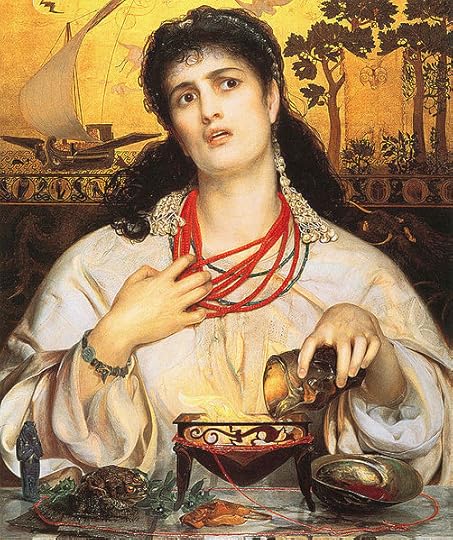 Anthony Frederick Sandys: Medea (1868)
Anthony Frederick Sandys: Medea (1868)She brewed up a sleeping potion to defeat the dragon that guarded the Fleece. What I like about this particular picture (which has some great magical detail, like the toad with the stone in its forehead, and the circle of red thread) is the sense of premonition - the look on Medea's face suggesting she sees the dark events ahead. The bright necklace suggesting blood.
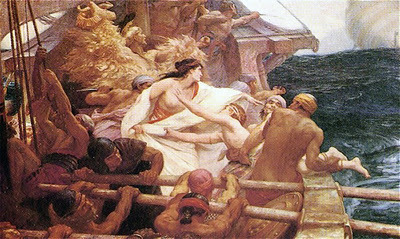 Herbert Draper: The Golden Fleece (1904)
Herbert Draper: The Golden Fleece (1904)Fleeing with the stolen Fleece, the Argonauts are pursued by Medea's father. To slow him down, she kills her younger brother - in some versions she hacks him to pieces as they will take longer to retrieve - and dumps the body overboard, knowing that the king will have to stop and give the corpse a proper funeral.
Medea is brick-hard. To the Victorian artist she epitomises woman as terrifying, psychotic and ruthlessly possessive,
 Alphonse Mucha: Medee (1898)
Alphonse Mucha: Medee (1898)This is an episode from nearer the end of Medea's story, as depicted on a theatrical poster. It's Art Nouveau style rather than Pre-Raphaelite. Medea finds that Jason has deserted her for an advantageous marriage to a princess. So she kills both their children as an act of revenge, and flies off in a chariot drawn by dragons. I've got a full-sized repro of this poster on my stairs at home!
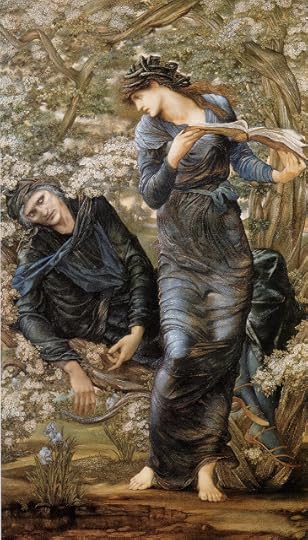 Sir Edward Burne-Jones (1833-1898): The Beguiling of Merlin
Sir Edward Burne-Jones (1833-1898): The Beguiling of MerlinMoving on from Greek myth to Arthurian legend, the witch Nimue comes a bit of light relief, relatively speaking. She seduces the wizard Merlin, learns his magic, and uses his own spells to bind him forever into a tree. I used to love this picture (I think Merlin looks hot!) until I realised how distorted are the proportions of Nimue's body. Sadly, I can't stop noticing that now and I find it just too irritating to look at :-(
I used this legend as a central plot device in my novel Wildwood.
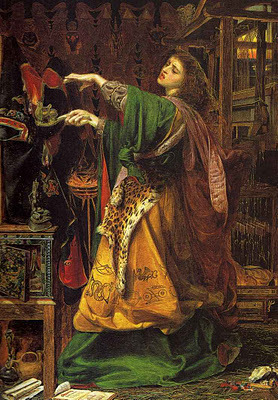 Anthony Frederick Sandys: Morgan le Fay (1864)
Anthony Frederick Sandys: Morgan le Fay (1864)This is Morgan le Fay, another Arthurian witch: Arthur's antagonistic half-sister and the mother of Mordred, who kills him. Blimey, standards of behaviour in the Good Old Days...
Take a look at the embroidery on her overdress. Those are genuine Pictish symbols copied from standing stones in Scotland. I presume the artist used antiquarian travel-books as his source, but it's still a splendid piece of research.
 John Collier: The Oracle or The Priestess of Delphi (1891)
John Collier: The Oracle or The Priestess of Delphi (1891)The Pythia - the priestess of Delphi - wasn't really a witch, more a shaman-type. She would sit on the tripod chair as depicted, breathing in the poisonous fumes from a fissure in the earth (supplemented by the burning of laurel leaves sacred to Apollo, also poisonous) and - completely stoned - she would prophesy in ecstatic gibberish which was interpreted by priests, to enquirers, in exchange for cash.
 John William Godward: The Delphic Oracle (1899)
John William Godward: The Delphic Oracle (1899)I think Godward has pretty much abandoned all pretence that the interest in these depictions lies in mysticism and ancient history.
 George Wilson: The Spring Witch (1880)
George Wilson: The Spring Witch (1880)Ditto Wilson. Interesting that the background is almost medieval in style - reminiscent of Bruegel.The witch is depicted as a semi-divine figure bringing Spring to a wintery world.
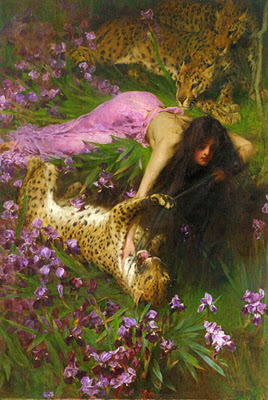 Arthur Wardle: The Enchantress (1901)
Arthur Wardle: The Enchantress (1901)Whereas this is most reminiscent of a Sunlight Soap advert. I think her flushed face would probably have been considered rosy and attractive at the time.
 John William Waterhouse: The Crystal Ball (1902)
John William Waterhouse: The Crystal Ball (1902)Of course Waterhouse would have to make an appearance in this post somewhere! In fact, twice. The subject of the painting above is definitely a witch and, judging by her accoutrements, not necessarily a very nice one either ... just the way Waterhouse likes them. Actually, it may have been a a bit too menacing for some tastes - in the 1950s a purchaser of this picture had the skull painted out! This was discovered by use of X-ray in 1994 and it's been restored since.

John William Waterhouse: The Magic Circle (1886)
But oh, this is my favourite witch painting. The realism, the detail - note the ancient Greek style figures embroidered on her robe, and the wild herbs she's gathered - the grim Mediterranean setting among the tombs and discarded bones, the sense that she really means what she's doing. See how the magic circle burns as she inscribes it! Just a brilliant picture. And she doesn't even have the usual Waterhouse Face.
Published on November 16, 2011 10:53
November 14, 2011
Eyecandy Monday

If you've a fondness for edgy BDSM romance then you may be looking forward to the Bound by Lust anthology, out in April next year (edited by Shanna Germain and including my story Being His Bitch among many other wickedly naughty contributions). Well, the cover has been changed!
Old cover here.
Here's the spiffy new version:
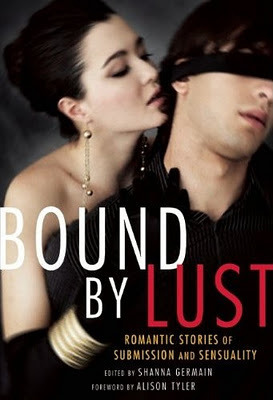
Still the same lucious contents!
Published on November 14, 2011 08:45
November 13, 2011
TftD: Nemi
Published on November 13, 2011 08:16
November 11, 2011
Movie review: Machine Gun Preacher

What?! What are the evil fiends of Hollywood trying to do to me? A new Gerard Butler movie? - yes! With him punching people and shooting them, not just some shite rom-com? - YES!
Playing a Born Again Christian missionary????
AIIIEEEEEEAAAAAARRRGH!
You understand my sense of conflict here, I hope.
 Stop talking about the Baby Jesus and get your kit off
Stop talking about the Baby Jesus and get your kit offWhat actually swung it was the fact that it's a true story, about a real guy called Sam Childers, who sounds ... interesting. And pretty conflicted himself.
 The real Sam Childers
The real Sam ChildersThe movie is an action biopic, covering several years of Childers' life. He starts out emerging from prison. He's a career criminal, a junkie, and a violent piece of trailer-trash with no apparent redeeming features at all. He undergoes a conversion experience, cleans his life up, sets up a successful construction company and pops out to East Africa to do some charity work for a couple of weeks - where he discovers the awful mess going on on the Uganda/South Sudan border, and in particular the plight of children coming under nightly attack from the LRA rebel militia. Horrified, Childers starts an orphange out there. Protecting the children involves taking up arms against their oppressors - something Childers is strikingly good at. A violent man, he just needs the right cause to fight for. Unfortunately the enemy in this instance is way too big for him to handle. He becomes increasingly obsessed and angry at the situation and how little people in the outside world are doing to help, and eventually undergoes a crisis of faith and abandons his wife and child in the USA in order to carry on his humanitarian work. However a small child reminds him of the good side of human nature, he is reconciled with his family, and the movie ends with them carrying on the good work. Which, in real life, Childers is still doing.
The controversial (and interesting) bit about Childers' mission is that it involves leading armed rescue missions into LRA-held territory. With extreme prejudice. Hence his "machine-gun preacher" sobriquet.

Well, frankly I found this fascinating - but frustrating too. The movie covers quite a long period in Childers' life, so is inevitably episodic. The director also seems wedded to the idea of "show not tell," which means that nobody explains anything. So it's really hard to get under the skin of the main character - you don't hear him talk about how he feels, except in the content-free Christian jargon of "fighting the Devil." And the successive scenes can feel really disconnected from one another. For example, the film leaves it terribly ambiguous as to whether Childers falls off the wagon and goes back to shooting up heroin at one point. It doesn't give him space to explain how he feels about the death of his best friend, or how that affects his beliefs, or how that crisis affects his congregation. It doesn't even tell you whether he recovers his faith in God by the end.
Most frustrating of all, there is no background or context given for the actions of the LRA, who are the villains of the piece and by anyone's standards a bunch of utter bastards. They abduct children and turn them into child soldiers and sex slaves. They kill indiscriminately. But why were they founded? What are their aims? Who are they? Criminally, the movie even gives the (inadvertant) impression that the LRA are Muslims, which is just SO wrong - the Lord's Resistance Army originated as a Christian militia of exactly the sort of muscular, charismatic stripe that Childers espouses. (And a secular aid worker points out to Childers just how much in danger he is of looking just like the LRA leader.)
So as a narrative this movie had me tearing my hair out. As a window into a physical and moral battleground, it was gripping and humbling. The themes in Machine Gun Preacher should be a challenge to everyone. To cynical atheists who sneer that all Christians are just complacent hypocrites. To Christians who believe that all that you have to do is have faith, and that God will intervene to fix everything. To anyone who holds that violence is never the answer. To anyone with any humanity at all, as we sit in our peaceful Western countries, and all this goes on, and we do nothing.
Sam Childers website
Sam Childers talks about the movie
P.S: The Catholic News Service described this film as "morally offensive."
Published on November 11, 2011 07:58
November 9, 2011
Witch Wednesday
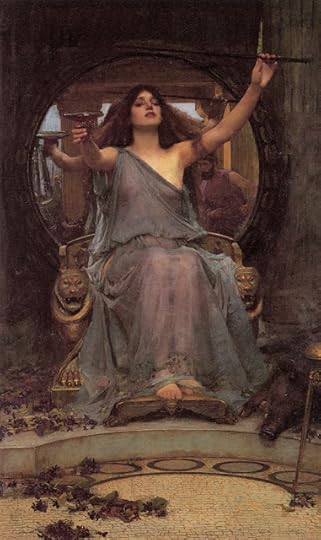 John William Waterhouse: Circe Offering the Cup to Ulysses (1891)
John William Waterhouse: Circe Offering the Cup to Ulysses (1891)Well, I rather missed my cue for Hallowe'en, but a day with a "W" in it is as much excuse as anyone should need for posting beautiful Victorian paintings of Witches. Those Pre-Raphaelites love their witches! Mysterious, powerful, sexually independent, threatening ... they play into all sorts of male fantasies. Especially as - in the example above - they seem to have a tendency to under-dress in public. I love the transparent muslin in that picture, and the sneaky depiction of her nipples .. as well as the fantastic use of the mirror. Naughty and gorgeous.
 John William Waterhouse: Circe Invidiosa (1892)
John William Waterhouse: Circe Invidiosa (1892)Circe is the one of the oldest witches in literature, though technically she's a minor goddess. Here she is using a magical potion to turn her love-rival Scylla into a hideous man-eating monster. This painting is particularly striking for the palpable malevolence, and the use of colour.
 John Melhuish Strudwick: Circe and Scylla (1886)
John Melhuish Strudwick: Circe and Scylla (1886)A gentler version of that poison-in-the-bath scene.
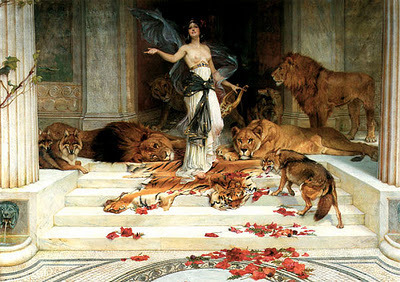 Wright Barker (1864-1941): Circe
Wright Barker (1864-1941): CirceBut her most famous appearance is in the Odyssey, where she is found holding court on the island of Aeaea with an entourage of lions and wild beasts, and transforms Odyssus' exhausted sailors into swine (insert your own metaphorical interpretation here).
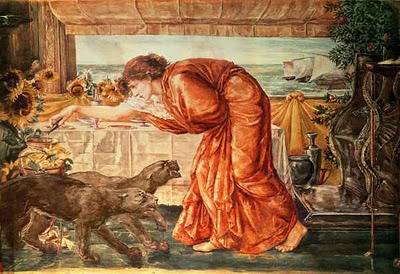 Edward Burne-Jones (1833-1898): The Wine of Circe
Edward Burne-Jones (1833-1898): The Wine of CirceI love the fawning great cats in these pictures. In dog circles the action below is known as "counter-surfing." You look away for a moment, distracted by contemplation of the Black Arts, and they're straight in there lapping up the magic potion.
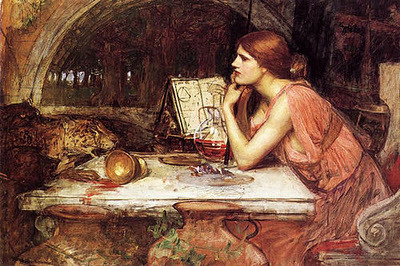 John William Waterhouse (yes, again - obsessed or what?): Circe or The Sorceress
John William Waterhouse (yes, again - obsessed or what?): Circe or The SorceressOkay, moving on from Circe...
No, actually I think I'll do the other witches next Wednesday. Circe is a jealous sort and I don't want to start a fight ...
Damn, I'm going to have to write a Circe story sometime, aren't I?
Published on November 09, 2011 09:50
November 7, 2011
Eyecandy Monday
Published on November 07, 2011 10:17
November 6, 2011
TftD: It happens

So, are we in the mood for a little comparative theology?
The "Shit Happens" list has a been round for a long time, in different incarnations and variations (I swear I've seen it on a tea-towel), but it still makes me smile. At its best it is a wry look at the way different philosophies and religions have attempted to deal with the age-old Problem of Evil:
"Is God willing to prevent evil, but not able? Then he is not omnipotent.
Is he able, but not willing? Then he is malevolent.
Is he both able and willing? Then whence cometh evil?
(Epicurus, 341-270 BCE)
So here's the version I like best:
Atheism: Shit happens.
"New" Atheism: Look - shit just happens. Why is that so hard to grasp, dimwits?
Agnosticism: Shit probably just happens, but if there's more to it than that we aren't qualified to comment.
Confucianism: Confucius says, "If shit has to happen, let it happen PROPERLY."
Buddhism: Shit happens, but try not to care.
Zen Buddhism: Shit is, and is not.
Taoism: Shit happens, so flow with it.
Catholicism: Shit happens because it's good for you. Anyway, you deserve it.
Protestantism: Let shit happen to someone else!
Islam: Shit happens if it is the will of Allah.
Hinduism: All this shit has happened before.
Moonies: Only really happy shit happens.
Televangelism: Shit happens because you aren't Born Again. If shit is still happening, it's because you haven't sent me enough money.
Darwinism: Survival of the shittiest.
Unitarianism: Shit happens. Have coffee and biscuits.
Church of England: Shit happens. Have a cup of tea.
Quaker: Please, let's not fight over this shit…
New Age: Visualise shit not happening. That'll be $300, thanks.
Christian Science: Shit is all in your mind.
Scientology: Shit happens if you're on our shit-list.
Judaism: Why does shit always happen to us?
and, of course..
Writer: My childhood was shit – let me share.
Published on November 06, 2011 10:06






